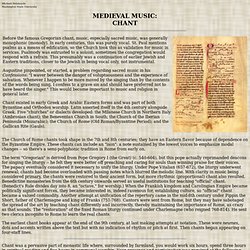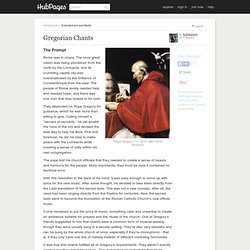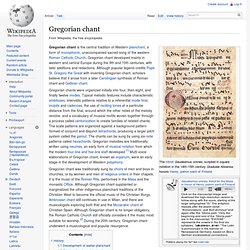

Medieval Music. Michael Delahoyde Washington State University The Church of Rome chants took shape in the 7th and 8th centuries; they have an Eastern flavor because of dependence on the Byzantine Empire.

These chants can include an "ison": a note sustained by the lowest voices to emphasize modal changes -- so there's a semi-polyphonic tradition in Rome from early on. The term "Gregorian" is derived from Pope Gregory I (the Great) (c. 540-604), but this pope actually reprimanded deacons for singing the liturgy -- he felt they were better off preaching and caring for souls than winning praise for their voices. The papacy eventually considered it necessary to unify the liturgy. Under Pope Vitalian (657-672), the liturgy underwent renewal; chants had become overloaded with passing notes which blurred the melodic line. The earliest chant books appear at the end of the 9th century, at last making attempts at notation. Matins (= morning) -- 2:00 am in winter, later in summer. Early Music Site Medieval Index. Gregorian Chants. Rome was in chaos.

The once great nation was being plundered from the north by the Lombards, and its crumbling capital city was overshadowed by the brilliance of Constantinople from the east. The people of Rome sorely needed help and needed hope, and there was one man that they looked to for both. They depended on Pope Gregory for guidance, which he was more than willing to give. Calling himself a “servant of servants,” he sat amidst the ruins of the city and devised the best way to help his flock. First and foremost, he did his best to make peace with the Lombards while creating a sense of unity within his own congregation. The pope told his church officials that they needed to create a sense of beauty and harmony for the people. With this resolution in the back of his mind, it was easy enough to come up with lyrics for the new music.
Gregorian Chant Notation. Gregorian chant. Gregorian chant is the central tradition of Western plainchant, a form of monophonic, unaccompanied sacred song of the western Roman Catholic Church.

Gregorian chant developed mainly in western and central Europe during the 9th and 10th centuries, with later additions and redactions. Although popular legend credits Pope St. Gregory the Great with inventing Gregorian chant, scholars believe that it arose from a later Carolingian synthesis of Roman chant and Gallican chant. History[edit] Development of earlier plainchant[edit] Musical elements that would later be used in the Roman Rite began to appear in the 3rd century.
Scholars are still debating how plainchant developed during the 5th through the 9th centuries, as information from this period is scarce. John the Deacon, biographer (c. 872) of Pope Gregory I, modestly claimed that the saint "compiled a patchwork antiphonary",[11] unsurprisingly, given his considerable work with liturgical development. Origins of mature plainchant[edit] Abbaye de Solesmes - Histoire du Chant Grégorien. Gregorian Chant is a musical repertory made up of chants used in the liturgical services of the Roman Catholic Church.

In fact, the liturgical tradition which the Church has given us is a vocal, monophonic music composed in Latin using sacred texts from the Ancient and New Testaments. This is why Gregorian Chant has often been called a "sung Bible". Linked intimately to the liturgy in this way, the goal of the Gregorian melodies is to favor spiritual growth, reveal the gifts of God and the full coherence of the Christian message. What we call Gregorian chant today first appears distinctly in the Roman repertory of the fifth and sixth centuries. Its implimentation and perhaps some of its composition was in the hands of a group of ministers in a service specially dedicated to the Roman basilicas, the schola cantorum.
The texts (words and some musical notations), committed to writing in books, become at this time an official reference text.